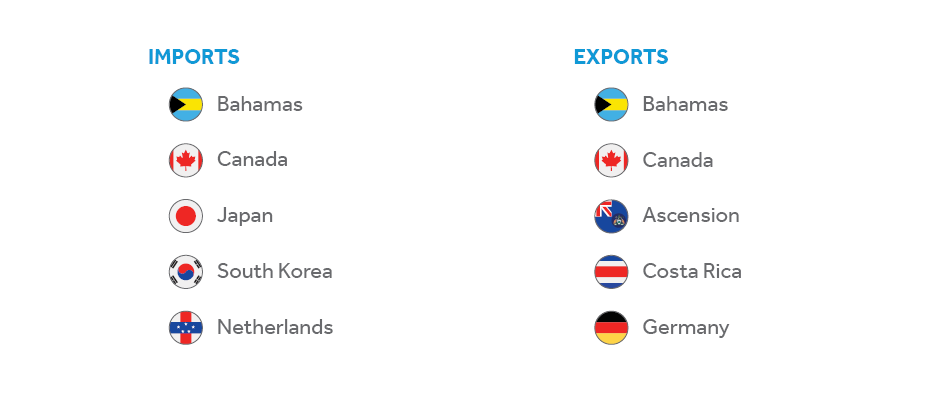Port Canaveral is a world-class deep-water seaport for global trade. For nearly seven decades, the Port has served as a critical gateway connecting commerce and consumers throughout Florida and the southeastern United States. Today, the Port continues to play a vital and historic role in supporting U.S. military operations, government, military and commercial space exploration and commerce.
Port Canaveral has a significant position and responsibility in building and sustaining a strong economy on Florida’s Space Coast and the Central Florida region – as it is the 10th largest consumer market in the U.S. with economic growth well above the national average. The Port and its Foreign Trade Zone #136 serve as a unique quadri-modal transportation hub: linking sea, land, air and space with the benefits of a deep-water seaport that includes easy and efficient highway access; unrestricted airdraft; -43 deep- water sea access; and, uncongested multipurpose berthing.
Port Canaveral is perhaps best known as the second busiest cruise port in the world, hosting some of the largest cruise vessels from the largest cruise brands in the world with millions of multi-day passenger embarkations annually.
The Port currently has a total of seven cruise terminals with several recently undergoing major renovations to further support industry growth.
Prior to the onset of the global COVID pandemic in March 2020 and the shutdown of cruising in the United States, Port Canaveral was hosting nearly 5 million multi- day revenue cruise passengers annually. In FY 2020 that number dropped to 2,261,431, and in FY 2021 it was 233,216. However, in FY 2022 the number of homeported cruise vessels at Port Canaveral grows to 11 – the highest number of cruise ships in the Port’s history — and the Port is anticipating passenger levels to approach or potentially exceed pre-pandemic levels.
Named “World’s Best Cruise Port” by Global Traveler Magazine in 2019, and “Best Cruise Port in the U.S.” by Cruise Hive in 2019 and 2021, Port Canaveral is the first LNG cruise port in North and South America.
Carnival Cruise Line’s Mardi Gras – a 180,000-ton cruise ship powered by cleaner-burning LNG, arrived in June 2021 at the Port’s brand new 188,000 sq. ft. Cruise Terminal 3 – the Mardi Gras’s new home – and began sailing 7-day Eastern and Western Caribbean itineraries from Port Canaveral on July 31, 2021. The $163 million terminal, berth works and adjacent 1,800 vehicle parking garage was the largest capital project in the Port’s 68-year history.
In FY 2021, to support the arrival of LNG powered vessels, Port Canaveral commissioned into service a high-tech fireboat designed and purpose-built to provide enhanced marine and LNG firefighting and rescue capabilities. The $4.8 million “Canaveral Fireboat 2” is a 65-foot Marine Firefighting Rescue Vessel equipped with conventional and dry-chemical firefighting apparatus to ensure the safety of the Port’s growing maritime operations and expanding space enterprises in the region.
In FY 2019, Port Canaveral hosted nearly 4.6 million revenue cruise passengers through its state-of-the-art terminals and 6 million tons of cargo, including dry and liquid bulk, break-bulk, project, and containerized. In FY 2021, following an 18-month suspension of cruising due to the global COVID pandemic, cruising is gradually resuming from Port Canaveral while cargo operations expanded, continuing a growth pattern which began in FY 2020.
Although approximately 75-percent of the Port’s total revenue is derived from its cruise business, the Port has an increasingly diversified cargo portfolio and growing needs to support the region’s commercial space operations.
The Port is investing in increasing its operational capabilities and capacity to meet the needs of today’s larger more sophisticated vessels; add value to the Port’s capabilities; and, to maintain its competitive position for handling current and future business demands.
The Port’s five-year capital improvement program was paused in FY 2020 and FY 2021, but is back on track for FY 2022 encompassing harbor and landside infrastructure improvements, such as renovating cruise and cargo terminal facilities, as well as building and refurbishing multi- purpose deep-water berths to keep pace with demands and promote economic prosperity for the region.
Goals & Objectives
- Diversify Port Canaveral’s business portfolio with cargo terminal expansion and uplands development projects to accommodate more bulk and breakbulk cargo, energy products storage and distribution (transportation fuels and LNG).
- Increase cargo handling capabilities and add capacity for more flexibility to accommodate diverse commodities and increased heavy lift and project cargo for expanding commercial space operations.
- Improve berth capacities and capabilities to accommodate increasing vessel size and tonnage of cargo and cruise ships.
Current or Planned Investments
- Renovating/rebuilding North Cargo Berths 3 and 4.
- Stormwater improvements and utilities relocation to improve infrastructure resiliency, and expand land utilization and suitability of approximately 34 acres for uplands development.
- Acquiring second mobile harbor crane to substantially increase the Port’s cargo handling capabilities.
- Relocating and/or improving access roadways and installing new signaling to improve traffic access /egress and improve public safety and security.
- Cruise terminal expansion and berth improvements to increase flexibility to accommodate larger cruise vessels.
Accomplishments
- $110 million in total revenue for 2019 (highest in Port history)
- Completion of newly-built Cruise Terminal 3 complex in June 2020 to homeport Carnival Cruise Line’s Mardi Gras – the largest and newest class of ship and the first LNG powered cruise ship in North or South America..
- Carnival’s Mardi Gras arrived in June 2021 and began revenue sailings on July 31, 2021.
Hinterland
Port Canaveral’s hinterland includes the Central Florida region paralleling the I-4 corridor and the Central Florida I-95 corridor.
Cargo: Central and North Florida counties of Brevard, Polk, Indian River, Orange, Osceola, Seminole and Volusia.
Cruise: The U.S., Europe, the Bahamas and the Caribbean, Mexico, and Central and South America.
Trade Partners

Mission
Serve the district and region by facilitating waterborne commerce, creating employment, accommodating port- related business and industry, and otherwise positively impact the economic growth of the district.

